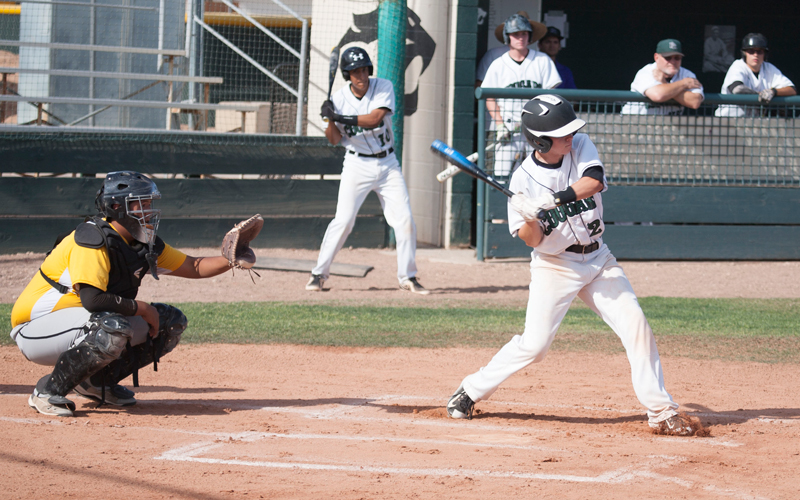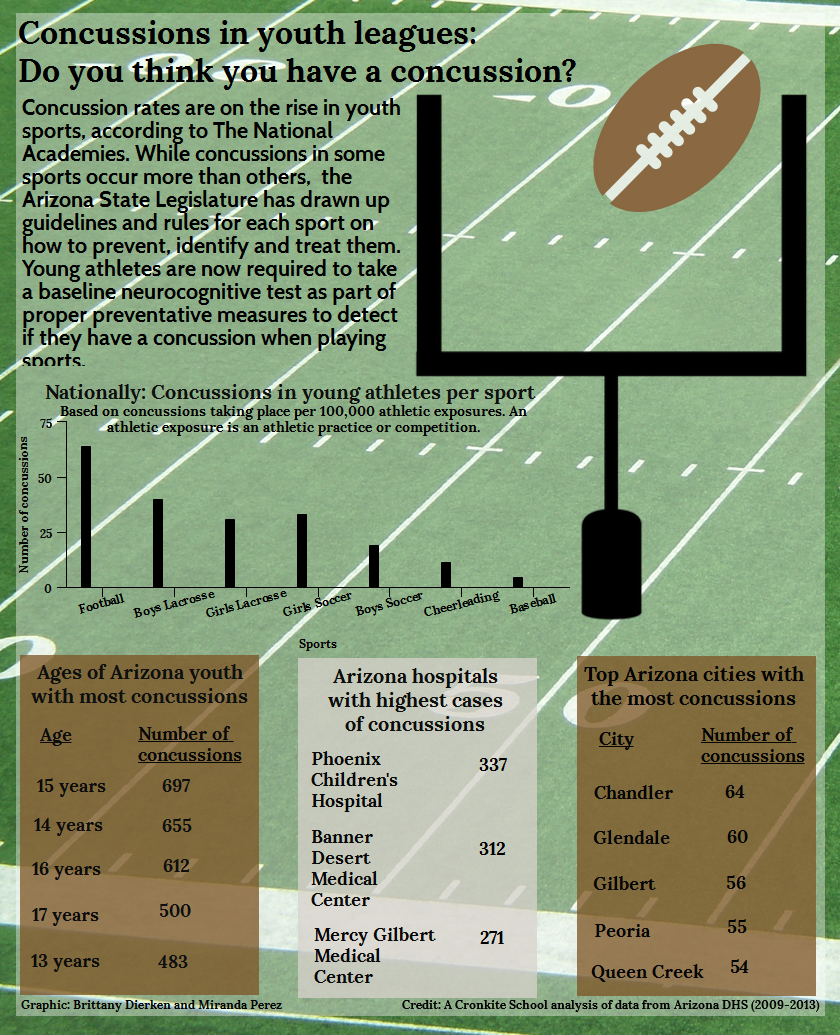
Phoenix Christian shortstop Kyle Janes recently suffered a concussion and went through the Barrow Concussion Network before returning to play. (Photo by Ben Brown)
Kyle Janes plays linebacker for Phoenix Christian High School. He suffered a concussion on the field this year. But the injury came in a less expected spot: the baseball diamond.
“I backhanded it and it hit off my glove, hit me right here in my forehead,” said the freshman shortstop, pointing to the middle of his brow.
Janes picked up the ball and threw it to first, but the damage was already done.
Phoenix Christian athletic trainer Dayna Tierney noticed Janes looked disoriented, administered a concussion test and determined Janes needed to come out of the game.
Janes saw Dr. Kareem Shaarawy at St. Joseph’s Hospital and Medical Center, who assessed his injury and held him out of baseball for two weeks.
Shaarawy advised Janes to attend half days of school for the week after his injury.
Janes returned to Shaarawy’s office and continued to show concussion symptoms on the first visit. It wasn’t until his next visit that he was given the all-clear to return to play.
He may not recognize it, but Janes participated in the Barrow Concussion Network’s three-pronged strategy to combat concussion in athletes.
The network is a collection of partners in Arizona devoted to educating, diagnosing and treating athletes from grade school through the professional ranks.
It is made up of the Barrow Neurological Institute, the Arizona Interscholastic Association, A.T. Still University, the Brain Injury Alliance of Arizona, the Arizona Cardinals and Arizona State University. Each entity fulfills a slightly different role within the network, making up one of the most comprehensive concussion-based groups in the nation.
Education: Barrow Brainbook
Prior to the football season, Janes and his team completed Barrow Brainbook, a 50-minute educational course about issues surrounding concussion. The course mimics social media, and students can agree or disagree with posts and comments made by characters with the goal of answering in the most brain-healthy way.
“Every single athlete in the state of Arizona is required to take this before they step onto the field, onto the court, into the water,” said Dr. Javier Cárdenas, who spearheads the project as the director of the Concussion and Brain Injury Center at Barrow. “We’ve had over a quarter million kids complete this education.”
Students must pass with a score of at least 85 percent before they receive a certificate verifying that they have completed the course. They must show their coaches the certificate to participate with their team.
Arizona State graduate students in educational technology helped Barrow develop Brainbook in 2011.
The course is about more than avoiding concussion.
“We want them, if they think they have a concussion or if they feel like they have concussion symptoms, to report it to their coach, to their parent, to their athletic trainer or to another adult,” said Tamara McLeod, the director of A.T. Still’s athletic training program. “I think a lot of them don’t understand that it can affect their schooling.”
McLeod used the analogy of a knee injury – it’s obvious to students and those around them that even once the knee brace comes off, there’s still work to be done.
“Unlike the example, post-surgery in a brace, a concussed athlete normally looks normal. They look fine, they act fine for the most part and yeah, they want to go back to play,” McLeod said.
Kim Rodgers, the athletic trainer at Mountain Ridge High School and an A.T. Still graduate, stressed the importance of trainers interacting with and educating families at parents’ activities throughout the season. She explains to parents the different elements of the network so they understand the system working to protect their children.
“It gives the whole family definitely a comfort level,” she said.
The theme of education even extends to A.T. Still. McLeod’s program provides graduate students as athletic trainers for some area high schools. Many graduates of the program work at Arizona high schools and community colleges, according to McLeod, but the program has also worked to reach schools without direct affiliations to A.T. Still.
One A.T. Still graduate student working in the field is Tierney.
Tierney, Rodgers and all other Arizona high school athletic trainers administer a baseline test at the beginning of the year called ImPACT (Immediate Post-Concussion Assessment and Cognitive Testing). Neither Tierney nor Rodgers uses ImPACT for immediate assessment, though. Rather, they and the doctors they partner with use it to determine if an athlete is ready to return to play after a concussion.
The NFL and NHL both use ImPACT, which measures concussion symptoms on a Likert scale of 1-7 and tests various cognitive functions, including different types of matching and memory. The network provides ImPACT to all the schools in the state at no cost.
Tierney said there’s a different test athletic trainers use to diagnose concussion on the sidelines, the test she used to diagnose Janes.
“The one we mainly use is called the SCAT 3, Tierney said, referencing the third edition of the Sport Concussion Assessment Tool. “It has about five different sections: It tests memory, cognition, recall and balance and motor function as well.”
The athletes at Phoenix Christian already know what’s probably coming if Tierney takes out the SCAT.
“My kids know me well enough now to know that if I’m testing them for a concussion, if we’re already to that point, more than likely they’re concussed,” she said. “Of course, they’re disappointed but I think most of them are feeling so cruddy at that point that they’re like, ‘Yeah, I want to go home and sleep so that’s fine with me.'”
Some athletic trainers also use Sway, a smartphone application that measures balance, to get a better idea of the athlete’s condition.
Rodgers said she gives parents of concussed athletes the option of going to urgent care. She always answers questions and provides them a handout on concussion from the Centers for Disease Control and Prevention.
After sideline diagnosis, there’s still the issue of sending the athlete to a neurologist to determine the severity of the injury and map out a plan of action for both academics and athletics.
Treatment: Patience is a virtue
Tierney said the neurologist dictates the recovery schedule for the athlete. That timeline not only approaches time away from contact sports but also time away from physical activity in general. It often includes missing some classes.
Cárdenas said the network has five concussion specialists available for consultation, whether in their office or sometimes through telemedicine, a Skype-style format that allows the doctor to assess the patient remotely.
Even with the decreased activity of half days at school, Janes felt the effects of his head injury.
“I remember in computer class, I’d be looking at the screen and then after five minutes my head would start hurting and I couldn’t focus and so I had to like close my eyes for a little bit,” he said. “It was kind of tough the first week but the second week was a whole lot better.”
McLeod, Rodgers and Tierney all stressed the importance of cognitive rest when recovering from a concussion.
“The next step is making sure that teachers understand that the concussion can result in certain symptoms and sometimes some basic accommodations might need to take place in the classroom on a temporary basis,” McLeod said.
After some rest, students return to class incrementally, ramping back up to their normal workload. McLeod said students should always return to the classroom before returning to their sport. Tierney said she tries to relay the importance of long-term brain health to the students to help them be patient.
“You’ve got to kind of take it out of the context of today and think kind of down the line because we don’t want it to cause other issues,” she said.
McLeod agrees.
“I think some of the best role models are those that have not rushed back to play in the professional ranks,” she said. McLeod singled out Pittsburgh Penguins superstar Sidney Crosby, who missed the second half of the 2011-12 season and the beginning of the 2012-13 campaign after suffering a concussion in the Winter Classic on Jan. 1, 2012.
The process takes the decision of returning away from the athlete, coach and parent and puts that responsibility in the hands of those with the medical background to assess the athlete’s condition: athletic trainers and neurologists.
Janes said he and his father were anxious to get him back on the field as quickly as possible, but it was worth the wait to be sure he was healthy.
“I didn’t like it at all but I was cheering on my team and wishing the best for them,” he said. “Actually, I think they won all the games that I was out so I was happy for them.”
The athletic trainer keeps an eye on the student and the doctor consults frequently with the student until the doctor determines it is time to retest using ImPACT.
Janes knew he was in good hands after taking the test a second time. He scored higher than he did on his baseline test in the fall.
He’s back playing shortstop and pitching for the Cougars after a successful trip through the Barrow Concussion Network.

